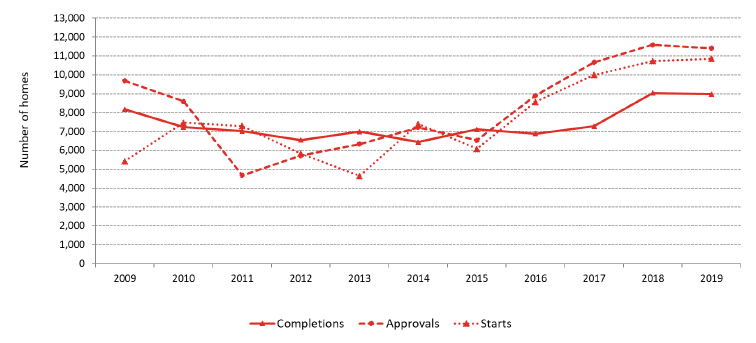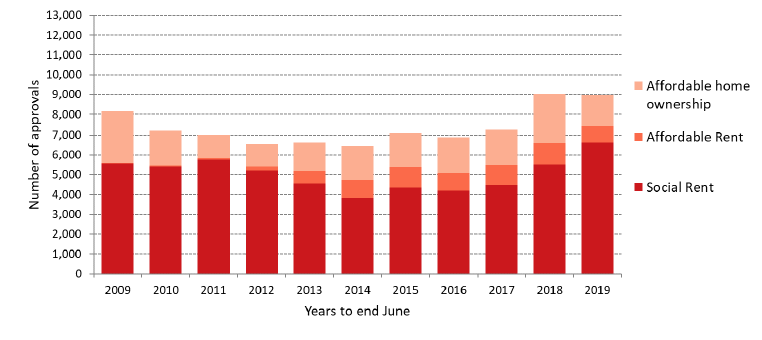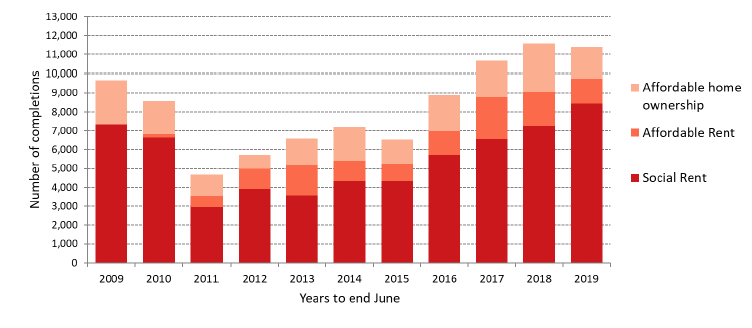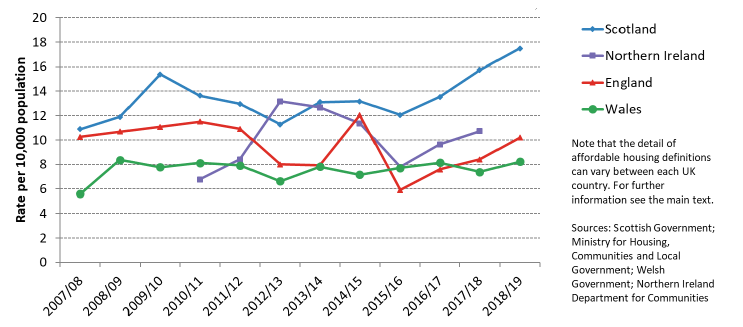Housing statistics quarterly update: December 2019
Trends in new build housing starts and completions by sector, and the Affordable Housing Supply Programme.
Affordable Housing Supply – up to end September 2019
Affordable Housing Supply Programme (AHSP) statistics reflect the broader supply of affordable homes (i.e. for social rent, affordable rent and affordable home ownership) and include off the shelf purchases and rehabilitations as well as new builds. The social rent new build element of this covers largely the same houses referred to in the social sector new build section of this report. Statistics for the AHSP are available up to the end of June 2019. As a result they have been presented here for the year to end September. This differs from the figures in much of the remainder of this report which cover years to end June.
Quarterly affordable housing supply statistics are used to inform the Scottish Government target to deliver 50,000 affordable homes, including 35,000 homes for social rent, over the period 2016/17 to 2020/21, and reflect the number of affordable homes delivered that have received some form of government support through loans, grant or guarantees
Approvals, starts and completions are all measured for the AHSP. Approval is the point at which funding is granted and, along with completion, is a significant part of the administration process meaning that the data should be of good quality. Starts meanwhile can be recorded at any point in the development, for example when site clearance begins or any point up to the beginning of ground works for foundations. As a result approvals are generally deemed a better measure than starts for AHSP data.
Social Rent includes Housing Association Rent, Council House Rent as well as Home Owner Support Fund Rent.
Affordable Rent includes Mid-Market Rent (MMR), National Housing Trust (NHT) Rent as well as other programmes such as the Empty Homes Loan Fund (EHLF) and Rural Homes for Rent (RHfR).
Affordable Home Ownership includes Open Market Shared Equity (OMSE), New Supply Shared Equity (NSSE), Shared Ownership (LCHO) as well as other programmes such as Home Owner Support Fund Shared Equity.
Chart 10: There have been substantial increases in annual Affordable Housing Supply Programme (AHSP) starts and approvals since 2015, and substantial increases in completions since 2017 (years to end Sept)

A total of 2,063 affordable homes were completed in the quarter between July and September 2019, a decrease of 7%, or 152 homes when compared to the equivalent quarter in the previous year. This brings the total for the year to end September 2019 to 8,976, down 1% (58 homes) on the 9,034 completions in the previous year.
Between July and September 2019 a total of 2,195 affordable homes were approved. This is 554 (34%) more than in the same quarter in the previous year. It brings the total for the year to end September 2019 to 11,398 approvals, down 2% on the previous year.
There were 2,644 affordable homes started in the quarter July and September 2019, a 22% increase, or 485 more homes than the same quarter last year. This brings the total for the year to end June 2019 to 10,855, up 1% (128 homes) on the 10,727 starts in the previous year.
Chart 11 below shows that total affordable housing supply programme completions decreased by 1% in 2019 (year to end September). In the latest year, social rent completions accounted for 74% of all completions, with affordable rent and affordable home ownership making up 9% and 17% of the total, respectively.
Chart 12 below shows that the total affordable housing supply programme approvals decreased by 2% in 2019 (year to end September). In the latest year, social rent approvals accounted for 74% of all approvals, with affordable rent and affordable home ownership making up 12% and 14% of the total, respectively.
Chart 11: In the latest year, Affordable Housing Supply Completions consisted of 74% social rent completions, 9% affordable rent and 17% affordable home ownership (year to end September)

Chart 12: In the latest year, Affordable Housing Supply Approvals consisted of 74% social rent approvals, 12% affordable rent and 14% affordable home ownership (year to end September)

Comparison with the rest of the UK from 2007/08 to 2018/19
This section compares how the level of affordable housing supply per head of population varies between Scotland and other UK countries, to help meet user demand for cross country analysis on this.
Each of the countries of the UK produces their own statistics on affordable housing supply[2]. Whilst there are some differences in the detail of affordable housing definitions and products used by each country, some comparisons can be made on how affordable housing supply varies per head of population.
Chart 13 below illustrates how the figures per 10,000 population have varied across the 2007/08 to 2017/18 period. Between 2007/08 and 2017/18, the annual average supply of affordable housing per head of population in Scotland has been 13.4 homes per 10,000 population, higher than England (9.5 homes per 10,000 population), Wales (7.6 homes per 10,000 population), and Northern Ireland (10.1 homes per 10,000 population). In 2018/19 the figures were 17.5 homes per 10,000 population in Scotland, 10.2 in England, and 8.2 in Wales.
Chart 13: Total Affordable Housing Supply Completions as a rate per 10,000 population - Scotland has had annual rates above all the other UK countries in each year since 2007/08, except during 2012/13

Note that statistics for England and Wales both include developer-funded Section 106 supply, although for England it is thought that some will be missed as local authorities are not aware of it all. Northern Ireland does not currently have an equivalent mechanism. Data for Scotland include Section 75 units receiving some form of government funding. Data are not available to estimate the number of affordable homes delivered without central government funding in Scotland, but it is thought that the numbers of these homes may be relatively low based on current estimates of the number of funded Affordable and Section 75 homes being delivered.
In addition to the differences in total affordable supply between each country, there are also some differences in the use of different affordable housing products within the mix of overall affordable housing in each country. For example in England in recent years there has been a greater use of affordable / intermediate rent compared to social rent. Therefore when looking over the four years to 2018/19, in England there have been on average 4.6 affordable / intermediate rent homes completed per 10,000 head of population and 1.1 social rented homes completed 10,000 per-head of population. This compares to a rate of 1.8 for affordable rent homes and a rate of 9.3 for social rented homes in Scotland.
Work on the harmonisation and comparability of affordable housing statistics across the UK has been published as part of a programme of cross-UK Housing Statistics work3. On 6th November 2019 ONS released a comparison of affordable housing in the UK on affordable housing stock, supply, sales and characteristics compared between England, Scotland, Wales and Northern Ireland. The article brings together the published data from across the UK to present an overall picture of affordable housing, highlighting similarities and differences between the regions of the UK and discusses data considerations including data limitation and gaps: https://www.ons.gov.uk/peoplepopulationandcommunity/housing/articles/comparingaffordablehousingintheuk/april2008tomarch2018
In addition, a review of the definitions, terminology and the feasibility of the harmonisation of affordable housing statistical definitions was published on the same day. This report includes definitions and key types of affordable housing across the UK and provides a summary of the statistics available and a summary of next steps: https://gss.civilservice.gov.uk/policy-store/affordable-housing/
Contact
Email: Felix.Palin@gov.scot
There is a problem
Thanks for your feedback